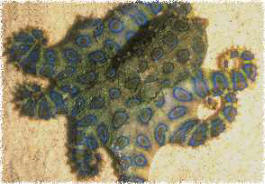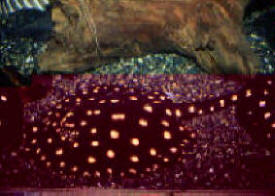INGESTED TOXINS
This potential killer is small, the northern (larger) species reaching only 20cm across spread tentacles. It is normally yellowish brown but when disturbed its blue rings become bright and obvious. It is not aggressive by nature but will bite when provoked. The venom is contained in the saliva, which comes from two glands each as big as the animal's brain. It has two components. One is probably most effective on crabs (its main prey) but relatively harmless to humans while the other, the same as that present in toad/puffer fish, probably serves as a defense against predatory fish. Humans, when bitten, usually do not feel the bite but soon notice a numbness around the mouth followed quickly by paralysis. Death can result from respiratory failure.
 This octopus lives in shallow water, typically in sheltered rock pools and crevices, cans and bottles. Never put your hands where you cannot see them. The venom is not injected but enters the wound in saliva. Washing the bite may therefore remove venom from the surface. This octopus lives in shallow water, typically in sheltered rock pools and crevices, cans and bottles. Never put your hands where you cannot see them. The venom is not injected but enters the wound in saliva. Washing the bite may therefore remove venom from the surface.
 STINGRAYS STINGRAYS
Stingrays will defend themselves by lashing out with whip-like tails equipped with one or two spines. Because they are barbed they can cause serious gashes and in about two-thirds of species they are also venomous. The spines are capable of penetrating wetsuits and shoe leather and have been known to kill people unlucky enough to have been stabbed in the chest.
Those at risk are people wading, who often get injured on the leg, careless fishers and divers who may get lashed by a startled stingray as they swim above it. Prevention involves shuffling feet when wading. Wash wounds thoroughly with sea water and remove spines carefully.
|